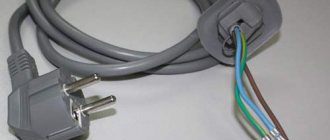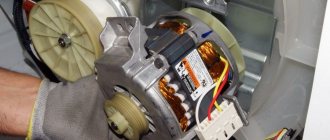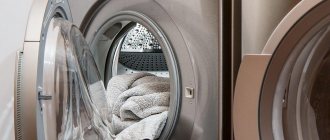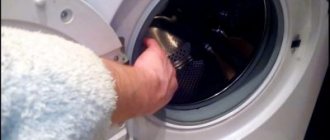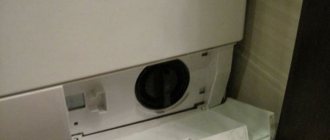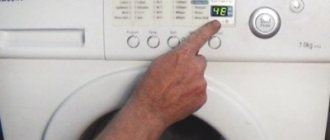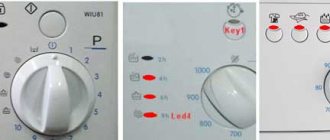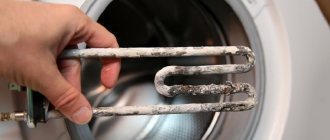Sooner or later, household appliances begin to cause problems. Often, before a breakdown occurs, its preconditions appear. For example, if you begin to notice that the washing machine is knocking during the spin cycle, then you should think about diagnostics and repairs. It is not recommended to delay in this case, otherwise the cost of restoration work will be much higher.
When spinning, the drum knocks loudly: what can you do yourself?
When the washing machine is operating in spin mode, the rotation of the drum reaches its highest speeds.
Noise and vibration inevitably occur. In some cases, such as improper installation or malfunction of certain parts, it may shake and make more noise than expected. It is not recommended to try to repair serious faults at home, as this risks damaging fasteners, the tank cross and other parts. However, if you notice excessive noise or shaking during washing, follow these steps:
- Switch the machine to spin mode and after it has drained the water, open the drum and remove some of the laundry. Then turn it on again. If the knocking and vibration stop, then the problem was overload.
- Start the unit at idle speed, then turn on the spin program. If the centrifuge continues to rattle, then the problem is most likely a malfunction of the internal mechanisms.
- Bend the hatch cuff and inspect the space between the tank and the drum. If there is a foreign object there, try to remove it.
- Open the filter hole by first inserting the tray. Clean it of small debris.
Has your washing machine started making an uncharacteristic knocking noise? This happens sometimes.
And this is not always a sign of a unit malfunction. Perhaps it is metal or large plastic parts of the laundry (buttons, zip runners, carabiners) knocking against the glass of the hatch and the drum. It is recommended to wash items with large fittings inside out or in special washing bags: this way there will be no knocking or damage to the machine.
If you loaded only soft clothes, and the knocking sound is clearly heard, then there is definitely a problem with the washing machine. Sounds uncharacteristic of washing occur due to a number of malfunctions. Only a specialist can correctly diagnose them, sometimes only with special equipment. But based on some signs, you can figure out on your own what happened to the assistant.
Attention! Before performing maintenance, disconnect the machine from the power supply and water supply!
The problem is caused by springs or shock-absorbing elements
The machine may vibrate and make a knocking sound in the drum if the springs and shock absorbers designed to prevent the machine from vibrating and maintain its balance have failed. Over a long period of operation, the elements are subject to wear, and this may cause extraneous sounds.
Note that knocking due to failure of shock absorbers and springs is a fairly common occurrence. What should be done in such a situation? One option is proposed - replacing parts that have ceased to fulfill their functional purpose. True, you will have to perform several difficult steps:
- the top panel of the body of the Indesit washing machine is removed;
- The tank is raised as high as possible and secured in a suspended position. Fix the tank with any object that happens to be nearby at that time;
- applying force, we pull the spring towards the drum, carefully disconnect it from the machine body;
- We connect a new analogue to the vacant space.
If the spring breaks, the drum may tilt to one side. However, it can look exactly the same if the shock absorber breaks down. To accurately identify the cause, it is necessary to disassemble the machine. This is done at the service center, and if there is a faulty spring, it is replaced. If you ignore the problem, then when washing the drum will poorly center the laundry and constantly sway.
In addition to the situations listed, there are others that cause the washing machine to knock. If you did not check the pockets before washing, then various small items may well get into the interior of the device and rattle during operation. The problem can be easily resolved:
- remove the front or back panel;
- unscrew the heating element;
- we take out large garbage;
- we put everything back together in reverse order.
Another reason for sharp sounds during spin cycles is worn bearings. With such a malfunction, a squeaking sound is heard from the washing machine. In this case, the bearings must be replaced with new ones. If the washing machine squeaks but there is no knocking noise, you can try lubricating all the bearings.
If your washing machine drum is knocking when spinning, then it is better to take care of repairs as quickly as possible, or at least avoid working at high speeds, then the machine will last much longer.
Solutions to the problem
After identifying faults, some of them can be fixed with your own hands, but for more complex ones you will need to disassemble the machine. How to fix the most common breakdowns?
If foreign objects get inside the machine, you will most likely have to disassemble it. To do this, you need to open the lid, remove the electric heating element and remove these things from the tank. In the event that it is impossible to reach foreign objects, you will have to completely remove the tank.
Replacing bearings is an inexpensive but rather complex repair. If they are not replaced, they may break the spider. To replace the bearings, the machine is completely disassembled and the tank is removed. The bearings are removed from their mounting points and replaced with new ones.
When repairing, it would be correct to replace all elastic parts. Before starting repairs, do not forget to buy a repair kit.
The transportation bolts must be removed before installing the machine in place - this will eliminate one of the causes of noise during operation.
Shock absorbers are not repaired, but replaced. To replace the dampers, you need to remove the rear cover of the car, unscrew the fasteners located below the shock absorber tank, remove them and install new ones. Then carry out all the steps in reverse order.
If the balance of the axle is disturbed, then it is necessary to tighten the nut on the pulley. In case of problems with the counterweight, it is necessary to remove the back or front panel (depending on the design of the device) and tighten all loose fasteners. If one of the weights breaks, and such cases are very rare, you need to replace it with a new one.
Leveling the machine is very easy. To do this, it must be installed on a flat floor, and by rotating the legs with a special key, we make sure that it does not swing.
Before you begin repairs, check whether you have the necessary set of tools, repair kits and spare parts. And do not forget to disconnect the repair facility from the power grid and water communications.
Breakage of machine parts
Tighten the pulley fastening nut
Like any mechanism, the washing machine, under the influence of small vibrations, loosens the fastenings of individual parts, which subsequently rattle, hitting the body and other structures of the washing machine. This often happens with the following devices:
- 1. Surge filter – protects the machine from voltage surges and is mounted on the rear panel. To get to it, you need to remove the top cover and use self-tapping screws to restore the fixation on the side wall.
- 2. The counterweight makes the apparatus stable; it consists of cast iron or concrete weights fastened with bolts. Most often installed from the bottom of the tank. It is not difficult to identify loose screws, you just need to tighten them. Deformed loads and hardware are replaced with new products.
- 3. Drum pulley - over time, the fastening bolt or nut weakens, the fixation of the part is broken, and it vibrates. After repair, it is customary to fill the joint with sealant to achieve greater effect.
Other breakdowns are more complex and occur during long-term operation. To eliminate them, you will need to disassemble almost the entire machine.
Bearing unit
A knocking sound accompanied by squeaking and grinding sounds indicates a bearing failure. Their breakdown is a consequence of the natural process of wear and tear; they change everything at once so as not to return to this issue again. The standard service life of a bearing is 5 years, and its serviceability is determined by spinning and rocking the drum up and down.
We recommend: How to remove tinting adhesive from car glass?
Repair of a bearing assembly is a complex operation. The entire device is disassembled. Some SMA models, for example Indesit, have a non-separable tank design. If damage occurs to the thrust bearing seat, then a third of the washing machine has to be replaced.
Shock absorbers and springs
Damping devices often become a source of noise accompanying the SMA. To replace the spring, perform the following operations:
- remove the top cover;
- hang the drum at the maximum height and fix it in this position;
- pull the spring element to the side of the drum and disconnect it from it;
- dismantle the part from the body and install a new one;
- Reassemble the structure in reverse order.
Failure of the shock absorbers leads to misalignment of the tank and drum, causing a knocking sound. These devices are not repaired, but replaced, all at once. Installing new dampers on most SMAs is not difficult, with the exception of Samsung and Hans - for these models you will need to remove the tank from the body.
Main causes of malfunction
There are several reasons why the drum in a washing machine knocks during the spin cycle.
This may indicate that:
- laundry in the centrifuge is distributed unevenly;
- a foreign object got inside;
- the machine is installed incorrectly;
- the spring mechanism has failed;
- the counterweight is broken;
- bearings are worn out;
- The power filter has come off.
If the machine begins to knock during the spin cycle, then you should not panic, since the cause of such a problem may not always be a breakdown. Sometimes the problem can arise due to the fact that things get together in one lump, which hits the walls of the drum and knocks. To avoid this problem, things should be thrown into the drum of different sizes. If your washing machine is a “new generation”, then it already has a function that allows you to evenly distribute all the laundry.
If the machine is installed incorrectly, then remember that at high speeds it may begin to “jump” and vibrate. To check that it is installed correctly, you need to place a level on top of the washing machine. In the photo below you can see what it will look like. To install the washing machine correctly, you need to tighten the legs.
If the problems we described above did not help get rid of the knocking, then there may be a more serious problem.
Noise Level Standards
The noise level of a washing machine of a certain model is specified in its instructions. It depends on what the drive is:
- in the belt version, its variations are from 60 to 72 dB (decibels);
- with the direct drive option, the threshold is reduced - from 52 to 70 dB.
What do these numbers say? The fact is that the user will still hear the operation of such a device, and absolutely silent washing machines do not exist. The technique works, but such audibility should not create discomfort. If such a feeling occurs, the device is clearly not working. And it’s good if the reasons turn out to be not very serious.
What to do if the washing machine knocks during the spin cycle
You need to take certain actions depending on the cause of the knocking.
This problem is typical for older machines. In them, when washing and spinning, things do not straighten out, but clump together. In order for the centrifuge to stop knocking, when loading laundry, you need to lay it out evenly, without overloading the drum. It is also advisable to wash bedding and clothing separately.
We suggest you read How to easily clean a washing machine
Sometimes, when operating the machine, small objects fall out through the holes in the centrifuge into the space between it and the outer tank, for example, a bra wire, a button, or a small item that might have fallen out of your pockets. In this case, in order to remove a foreign object, if it cannot be reached through the door cuff, the device will have to be disassembled.
If errors were made during the installation of equipment, then in accelerated operation this is especially noticeable. In this case, it is necessary to check the correct location of the unit and make the necessary adjustments. In order to determine whether the car is level, you can use a level. If distortions are detected, it can be moved to a more even surface. In some models, the position can also be adjusted using screw-in and screw-out legs.
Shock absorber wear
To fix internal damage, you will most likely have to contact a specialist. The springs that ensure smooth rotation of the drum become unusable due to prolonged or intense use, which causes excessive knocking. Replacing the shock-absorbing mechanism will solve this problem.
Counterweight failure
Another problematic part that causes the washing machine to start knocking can be the counterweight - a special weight designed to balance the moving structure during operation. If noise and rattling occur during the washing process, the reason may lie in a loose balancer mount. To eliminate this drawback, it is necessary to disassemble the body of the washing machine and adjust the position of the counterweight.
Bearing wear
If the washing machine is used for a long time or in violation of the general rules, then the drum bearings are also subject to wear, which ultimately leads to creaking and unwanted vibration. The bearing mechanism is replaced taking into account the model of the unit and its functional features.
A typical element of all models is a surge protector. It is located behind the back cover and serves to equalize electrical voltage. When the washing machine is operating, this part may become detached and knock on the body and internal parts. For repairs, the back panel is removed, after which the filter is screwed into place using new fasteners.
Sooner or later, household appliances begin to cause problems. Often, before a breakdown occurs, its preconditions appear. For example, if you begin to notice that the washing machine is knocking during the spin cycle, then you should think about diagnostics and repairs. It is not recommended to delay in this case, otherwise the cost of restoration work will be much higher.
Manifestations of unnatural noise
The quiet measured noise of a moving drum and a running motor occurs during washing in any model of machine such as a centrifuge. First, you should pay attention to the nature of the sound, which may indicate a malfunction:
- the sound is unnatural, it increases with each wash;
- The washing machine is especially noisy during the spin cycle;
- pronounced extraneous noise, similar to clanging, grinding or hitting.
Of course, the first thing that might come to the owner’s mind when faced with such a common phenomenon in a washing machine is that it’s just a sound due to the metal parts of the clothes themselves. But when you wash bed linen or towels, and the noise gets louder, it’s time to think about a malfunction.
Why is the sound of the washing machine heard most during the spin cycle? The fact is that at this stage of operation the centrifuge drum rotates the strongest and fastest.
This serves as a good test for all mechanisms. Accordingly, with the increase in the roar of the engine, noise during breakdowns will be more noticeable, since rapid movement rocks all other parts, including the body.
Counterweight
With the help of such elements, the Indesit washing machine is given stability. The part is a heavy block made of concrete. Most often in cars it is mounted directly under the top housing panel. Thanks to this counterweight, the washing machine does not vibrate when the drum rotates at maximum speed.
Over time, the fasteners that hold the counterweight unit in place weaken. The counterweight begins to oscillate and hit the tank. It is easy to fix such a malfunction; you just need to gain access to the counterweight and tighten all the fasteners.
To perform this work, disconnect the top panel of the Indesit machine, inspect the counterweight unit, tighten the fasteners. If after such prevention the block continues to vibrate, unscrew the bolts and place washers under them. Perhaps the stone will begin to hold better.
The tank itself is quite light and to weigh it down, counterweights are used in its upper and lower parts. Thanks to this design, the risk of rocking during washing is reduced. However, over time, the counterweight can cause problems for you: loosening and knocking loudly when spinning. This problem can be fixed quite easily:
- the machine must be disassembled;
- determine which of the two counterweights is loose;
- tighten the fastening.
If the counterweight is not tightened in time, it may fly off or break. At the same time, the washing machine begins to knock during the spin cycle: at high speeds, the drum begins to touch the walls.
Washing machine during spin cycle: drum rattles and unit vibrates
A small free play of the drum is initially provided by the manufacturers, but the permissible play does not cause any knocking during operation of the device. Extraneous sounds during the washing process in most cases are a consequence of wear of parts. To identify the real reasons, a sequential check of the main parts of the drum mechanism is performed.
The condition of the main elements that ensure normal rotation of the centrifuge, the correctness of its position, as well as the presence of possible deformations and damage are checked. Certain types of malfunctions may be indicated by features of improper functioning of the equipment. For example, when a shock absorber fails, the drum sags to one side, losing the ability to center things during washing.
Based on the results of technical diagnostics, the relevant parts are repaired, during which the shock-absorbing device, bearings or supporting crosspiece can be replaced with similar branded parts.
Why does the drum shake?
The bearings are damaged.
The shock absorbers are broken.
The crosspiece is cracked.
A foreign object is stuck in the tank.
These reasons cause increased play in the machine.
To correctly diagnose the problem, pay attention to the characteristics of the looseness, the size of the gap
How to check play
Spin the empty cylinder by hand. If it creaks when moving and touches the tank, it means the bearing has become loose. A broken bearing also causes leakage during the washing process.
Pull the drum towards you and release it. If it wobbles a lot, sways, falls out, sinks, or spontaneously separates from the cuff, the shock absorbers have failed.
When the drum moves, does the body shake, twist sharply, does it seem like the machine has “gone crazy”? Most likely the crosspiece is cracked.
The movements are smooth and silent, but is there something rattling and rattling on the walls? It looks like a small object is stuck in the tank. If you know how to use tools, you can fix these troubles at home.
There is a foreign object in the tank
A knocking sound in the drum of a washing machine from the Indesit company may appear from the presence of a foreign object inside the unit that is in the tank. This problem is considered more serious than previous cases because the system can suddenly jam. To get rid of the cause of the knocking, you should turn off the washing machine and disassemble it.
After disconnecting the washing machine from the electrical network, try to remove the foreign object using the hole near the water heater. The algorithm of actions is as follows:
- the Indesit washing machine is disconnected from all communication systems;
- the unit is installed in the center of the room to provide easy access to the rear panel of the machine;
- Unscrew the screws and remove the back cover of the case;
- disconnect the contacts of the water heating element;
- remove the nut holding the heating element;
- holding the heating element, carefully rock it, gradually removing it from its seat.
Causes of noise and knocking during spinning
First of all, it should be said that the noise may be acceptable, or it may be caused by a malfunction. It is in the latter case that the machine begins its “songs” and “dances”. Let's look at the main reasons for such buoyant behavior of the washing machine. There can be many of them, but the most common are the following.
- The bearings or seals on the drum drive – the shaft and crosspiece – are faulty. In addition to knocking, noise and vibration, there may be a burnt smell from the seals. Often it is the destruction of the seal that causes wear and destruction of the bearing - the ingress of particles, dust or moisture has a bad effect on the latter. When a bearing fails, special “iron” sounds and creaks appear. After the creaks, knocking and noise begins. Naturally, the drum and the whole machine vibrates strongly.
- Drum suspension parts - springs or shock absorbers - are faulty. It is also possible that the fasteners (ears) and dampers for these parts may be damaged. In such a situation, knocking, creaking and vibrations during spinning are inevitable.
- The counterweight or its fastenings are loose, loose or cracked. What it is? Usually this is a figured heavy balancer (weight) made of concrete or cast iron. It is located at the very bottom of the car, in the corners or on the side. It gives the machine body stability and reduces vibrations during operation, especially at high speeds. Of course, the worse its fastening and integrity, the more the car jumps and knocks.
- A small foreign object has entered between the wall of the drum and the tank. It could be anything - a coin, a bolt, a button. This situation may be accompanied by knocking and noise throughout the wash, being more noticeable during the spin cycle.
- Loosening or destruction of fasteners of various internal components of the machine. In this case, the cause of the noise may be a fallen hose, surge protector, pump housing - they simply hit the machine body or tank during operation.
- Another simple and common reason for increased noise is that you forgot to remove the shipping bolts when installing the washing machine. This often happens, especially when work is carried out in a hurry. In some cases, it is necessary to remove the plastic bushings for these bolts.
- Improper installation of the washing machine also causes noise and vibration during operation. The washing machine must be positioned strictly horizontally; for this, its legs have adjustments that allow you to raise or lower the desired side. The unit must be installed either on a flat, poured floor (concrete, solid slab), or on a thick and hard, but springy rubber mat. There is no need to place the car on a thin rubber mat - it will quickly press through.
The above factors are the most common causes of knocking and noise in the washing machine while spinning clothes. But this list is far from complete; there may be many more reasons. It all depends on the specific case.
In addition to these reasons, I would like to mention several others. For example, the presence of water in the drum, which leads to an imbalance during its rotation and it begins to hum. Another thing is, why is there water in the drum? As a rule, due to a clogged drain filter or poor pump performance.
Another reason is improperly laid out or bunched laundry. This is especially noticeable on narrow cars. The presence of buckles and fasteners in the laundry hitting the walls of the drum is a direct source of noise and knocking. A belt slipping off a pulley for a number of reasons also becomes a source of noisy and poor operation of the machine. And touching the tank against the hatch cuff is usually accompanied by a whistle.
There can be many reasons for the appearance of extraneous sounds during washing and spinning, and knocking does not always indicate a malfunction of household appliances. Let's look at the main reasons why a strange sound appears when the washing machine is operating:
- uneven distribution of things in the drum;
- improper installation of the washing machine;
- broken spring;
- shock absorber failure;
- problem with the counterweight.
Today it is difficult to imagine the life of every person without an automatic machine. If even small errors occur in her work, then this can cause significant panic in almost every person. The main problem with many devices is that the washing machine makes a knocking noise when operating.
You need to remember that most problems can be fixed on your own. In this article you will learn why the washing machine knocks during operation and what needs to be done to fix the problem.
Sometimes a new washing machine may make a knocking noise because the shipping bolts were simply not removed. In the instructions you can see their number and unscrew everything you need. If the drum of the washing machine knocks during the spin cycle, then the reason for this may be:
- The spring or shock absorber is broken. In most cases, the tank with the drum will hang on springs, and from below it will be mounted on shock absorbers. As a result, the tank will warp and may knock against other walls. If you encounter a similar problem, then you need to replace the broken spring with a new one. If you notice that a shock absorber has failed, then you will have to replace two at once. If you only replace one, then be aware that this may cause the load to be distributed unevenly.
- Counterweight. If you look at the washing machine tub, then you can see that there is a counterweight attached to it. This counterweight is necessary to ensure that the tank does not become loose during washing. If the fasteners become loose over time, then you may be faced with a counterweight problem. If the counterweight is broken, then it must be replaced. Such a breakdown can be encountered extremely rarely and only on low-quality washing machines.
We suggest you familiarize yourself with Water leaking from under the washing machine
During washing, the drum in the washing machine knocks for the following reasons:
- Small parts could simply get into the drum, which, as a result of prolonged washing, fell off the clothes or were placed in their pockets. During washing, these small parts can simply dangle between the drum and the tub. After removing the lid of the washing machine, you just need to loosen the fastenings and pull out the heating element. Through this hole you need to try to pull out all the small parts.
- The bearings have worn out. To understand this problem, you should simply take the drum and then twist it in different directions. If it produces a script, then the problem will be in the bearings. To fix this failure, you will need to replace all bearings, as well as additionally lubricate them.
- The pulley broke. This can happen if you use the washing machine for a long time. If the tightening is loose, then they need to be tightened and filled with sealant, which will provide additional fastening.
Sometimes the reason why a washing machine knocks when washing can be a surge protector, which will be attached to the back wall and may simply unscrew over time. In the future, a poorly attached bolt will simply hit the tank.
If the machine knocks when drawing water, then the cause may be a clogged water supply filter. Sometimes, when drawing water, equipment may make unnecessary noise due to strong pressure. If the Indesit washing machine is knocking, then remember that the tank in this brand will be glued together. This means that it will be simply impossible to disassemble such a tank. To get rid of the problem, the tank must be completely changed.
It may not always be possible to independently identify the cause of the knocking noise. That is why it is best to use the services of professionals.
A washing machine breakdown does not happen “suddenly”; the user can notice its preconditions in advance. If you notice that the drum is knocking in the washing machine, then an urgent check is needed, and possibly repairs.
You should not delay diagnostics, since the causes of extraneous noise in the MCA can be different, and this can result in serious and expensive repairs.
Experts recommend doing the following manipulations:
- Open the hatch and grasp the drum with both hands. By turning it in both directions, the user can hear a grinding noise. Its presence indicates a malfunction.
- Start the Indesit unit with an empty drum at maximum speed.
If during rotation there is a feeling of significant vibration, which is accompanied by loud sounds, this is a clear sign of a broken shock absorber or bearing.
- Typically, bearing grinding is accompanied by water leaking from under the bottom of the device. To make sure of this you need to look under the machine. If there is a puddle, the bearing and seal must be replaced.
- If there is a grinding noise, but no leakage, the shock absorbers should be replaced.
- Broken spring or shock absorber. The tank with the drum hangs on springs and is mounted on shock absorbers at the bottom. Over time, both the spring and shock absorbers wear out and can break or fail. Then the tank warps and may knock on the walls or other parts. A broken spring must be replaced with a new one. But if the shock absorber fails, then both will have to be changed at once. If you replace only one that has directly failed, then the load will be distributed unevenly and the one that was intact will quickly become unusable.
- Counterweight. An artificial weight is attached to the washing machine tank - a counterweight. It serves to prevent the laundry tank from swaying during washing and spinning. Over time, the fasteners may become loose. Then, after disassembling the machine, you just need to “tighten” the bolts. And if the counterweight is broken, you will have to buy a new one. Such a breakdown occurs quite rarely.
Where is the drum
A clear sign of bearing failure is difficult rotation of the drum of the Indesit, Samsung, Bosch, Ariston, Kandy washing machine. When rotating by hand, it may seem that the part has flown out of place and cannot be turned. But it is impossible to accurately identify the true reason why the drum is hanging from a superficial inspection.
It happens that a new, recently installed washing machine knocks if the transport bolts have not been removed. Check their number according to the instructions: you need to unscrew everything.
The reason why the washing machine drum knocks during the spin cycle may be:
Do-it-yourself troubleshooting
Many breakdowns can be fixed on your own, without contacting a specialist. It is important to use the correct tools and follow the instructions provided.
The washing machine is not installed correctly
Sounds may occur due to improper installation. To fix the problem, you need to check for the presence of shipping bolts. Some users forget to remove them after purchase. Using an open-end wrench, you need to adjust the legs of the machine. If the surface of the coating is too uneven, you can use silicone supports. They will dampen vibration and increase the area of contact with the floor.
Items in the drum are unevenly distributed
To eliminate the sound, you need to correct the imbalance of the laundry. The process of fixing the problem takes place in several stages:
- You must press the “Pause” button on the control panel.
- If the machine has already filled with water, it must be drained. This can be done by opening a small hatch. It is located at the bottom, under the laundry loading door.
- A filter will open that needs to be unscrewed. Water will gush out, so you must first place a container.
- Now you can open the stowage door and redistribute things inside the drum.
A similar problem often occurs in older type machines, since they are not equipped with the “Unbalance Protection” function. In addition, manufacturers now provide devices with an auto-weighing system. This allows the user to control the process of storing things. As a result of the introduction of such technologies, the occurrence of imbalance is minimized.
Owners of old-style cars need to carefully study the operating instructions. Firstly, it is necessary not to exceed the norm for stowing things. Secondly, in some modes it is necessary to load laundry less than the permissible level. Thirdly, small items of clothing need to be loaded together with large ones. This measure will also avoid the emergence of an imbalance.
A knocking noise during washing may also appear due to fasteners in contact with the walls of the drum during rotation. Therefore, it is advisable to wash clothes with a large number of accessories in a special bag.
Otherwise, such parts may come off when spinning at high speed. Sometimes the user forgets to check the pockets before loading.
Clothes containing loose change or other small items fall into the drum. They must be removed so that they do not penetrate further. To do this, you need to drain the water and open the door (according to the instructions given above). For ease of searching, things can be removed into the basin. Only after removing all foreign objects from the pockets can you load.
A foreign object has gotten between the tank and the drum
Items usually collect behind the hatch cuff or in the filter. Sometimes you have to resort to removing the heating element or tank. The location of the heating element is different, since the internal structure of the devices is determined by the manufacturer. Typically, to gain access to the part, you need to remove the front wall. Now you need to disconnect the wires leading to the heating element. The next step is to unscrew the bolt going down the center. Now the part can be pulled out, and then the foreign object can be removed.
The shock absorber (damper) has failed
To replace dampers, follow these steps:
- The top panel needs to be removed. To do this, you need to unscrew the screws located on the rear panel. And then push the top cover.
- Now you need to disconnect the dashboard. To do this, remove the tray by pressing on the central latch. Now you need to unscrew the bolts holding the dashboard. The contacts from the part must be carefully disconnected. Before doing this, it is necessary to photograph the position of all wires.
- Now you need to remove the hatch cuff and the metal clamp holding it. This is convenient to do with a screwdriver.
- It is necessary to disconnect the contacts and bolts of the hatch lock. Then the part needs to be removed.
- At the last stage, the front panel fastening is removed.
The process of removing dampers occurs as follows:
- To remove the lower mount, you need to unscrew the bolt.
- To dismantle the upper part, you need to remove the rods. To neutralize the latch, you need to secure the nut to the rod.
- Now you can remove the rod along with the shock absorber. It is convenient to use pliers for this.
The counterweight is loose
It is necessary to dismantle the front wall, since the counterweights are usually attached to them. You can adjust the position of the counterweight as follows:
- You must remove the tray completely by pressing the latch located in the center.
- In the opening that appears, you can see several bolts. They must be unscrewed to remove the control panel.
- Sometimes it is necessary to additionally press the plastic latches. You can use a flat-head screwdriver for this, but it is advisable to carry out the procedure carefully.
- Now you need to unscrew the fasteners located at the top of the front panel. Now the wall can be removed.
Now you have access to the counterweights, you need to carefully inspect them. If damage is detected, the part requires complete replacement. If the counterweights are working properly, you need to check the fastening. Before repairing, it is advisable to look at the location of the parts in the data sheet. On some models, the counterweights are located at the bottom or rear.
Bearings have failed
Replacing faulty bearings is a rather lengthy process, as you will need to completely disassemble the machine. Fortunately, purchasing a new part will not require new investments. However, if you delay repairs, the tank and crosspiece will break. In this case, replacement will no longer be justified, since purchasing a new device will be a more profitable option.
The following tools will be used during the repair process:
- set of screwdrivers, flat and Phillips type;
- adjustable wrench;
- a hammer, rubber or wooden (if necessary, you can use a regular one, but when working you will have to strike through thick rubber);
- set of open-end wrenches;
- lubricant (it is recommended to use lithol);
- chisel or wrench.
To get to the bearings, you will need to disassemble the device housing:
- It is necessary to dismantle the rear wall. To do this, unscrew all the screws around the perimeter. Equipment from some brands also requires removing the top panel.
- It is necessary to disconnect all contacts going from the tank to the sensors and heating element. (It is advisable to capture the process on photo or video).
- Now you need to remove the belt, which transmits impulses from the engine to the drum drive.
- To remove the heating element, you need to loosen the pressure shirt and press it inward. This will release the cuff; removal occurs through rotation passing at an angle.
- Use a wooden stick to secure the flywheel, which will prevent the flange from rotating. A screwdriver can be used if necessary, but extreme care must be taken. After all, a metal tool can pierce a drum.
- To remove the flywheel, you must unscrew the fixing bolt.
- To remove the drum, you need to remove the bolts holding the two halves of the tank together. This will allow you to get the part without completely disassembling the device. The first half of the tank will remain inside the car, housing shock absorbers and an electric motor.
To remove the bearings you will need to follow these steps:
- Using a hammer, you need to knock out the shaft. Care must be taken when working, as the part may be damaged due to too powerful impacts.
- Now you can see the oil seal and bearing. To remove the first part, you will need to pry it out with a screwdriver. If you can’t remove it, you can use a chisel and hammer. The end of the tool must be placed between the seal and the tank. Now you need to give the handle a few light blows with a hammer, this will allow you to remove the seal. After this, you need to remove the bearings - external and internal.
- Before installing new parts, the groove must be cleared of scale and dirt. Various detergents usually help. For severe contamination, you can use sandpaper.
- After cleaning, you need to install the inner ring into the seat, followed by the bearings and oil seal. The last part needs to be pre-lubricated with lithol.
- Before installing the tank on the shaft, it must also be freed from dirt and lubricated.
Line filter failure
Any user can change or screw on a broken filter. First you need to provide access to the part, so you need to unscrew the top panel. The part is located on the side wall, near the power cord. To eliminate the defect, you need to tighten the loose fastener.
Unevenly distributed laundry
This problem is typical for older models. Modern devices practically do not rattle, of course, if they are in good working order and installed correctly. Good alignment is facilitated by the presence of electronics, which allows you to distribute things more evenly and prevent imbalance in the drum. Old devices cannot assess how well the drum is centered, and whether there are crumpled laundry in it. Spinning occurs in any case, and then the drum may knock on the walls or other elements of the washing machine.
The problem is not related to the breakdown
To understand why the Indesit washing machine makes a knocking sound and bounces during the spin process, you should diagnose the device. There are several reasons that could create such a situation. You should start with those that do not mean that a breakdown has occurred in the car:
- Things are unevenly distributed in the washing machine drum. Clothes loaded into a washing machine sometimes form a large lump and knock on the walls of the tank, causing imbalance. In such a situation, eliminating the knocking is quite simple - stop the running program, wait until the door is unlocked and distribute the items evenly in the drum. Note that a similar situation can arise with older models of washing machines. New units have a special function that allows you to weigh loaded items and distribute them evenly throughout the drum;
- The washing machine is installed on an uneven surface. Quite often, the machine makes extraneous sounds due to the fact that the requirements for its installation have been violated. By adjusting the location of the unit, you can eliminate the strange knocking noise. To determine whether the washing machine is unevenly placed, it is necessary to use a building level to check the evenness of the installation. If such a tool is not available, the car should simply be rocked. The device, if installed correctly, will remain stationary. If an uneven installation is detected, the problem can be solved using special stands, placing them under the SMA body.
Shock absorber failure
A broken shock absorber has very similar symptoms to a broken spring:
In addition to the shock absorber, the mount may break, or the mounting bolt may simply become loose. It is possible to determine why the extraneous sound occurs only after disassembly. It is recommended to first carry out diagnostics by calling a specialist. After identifying a malfunction, the shock absorbers are replaced with new ones.


